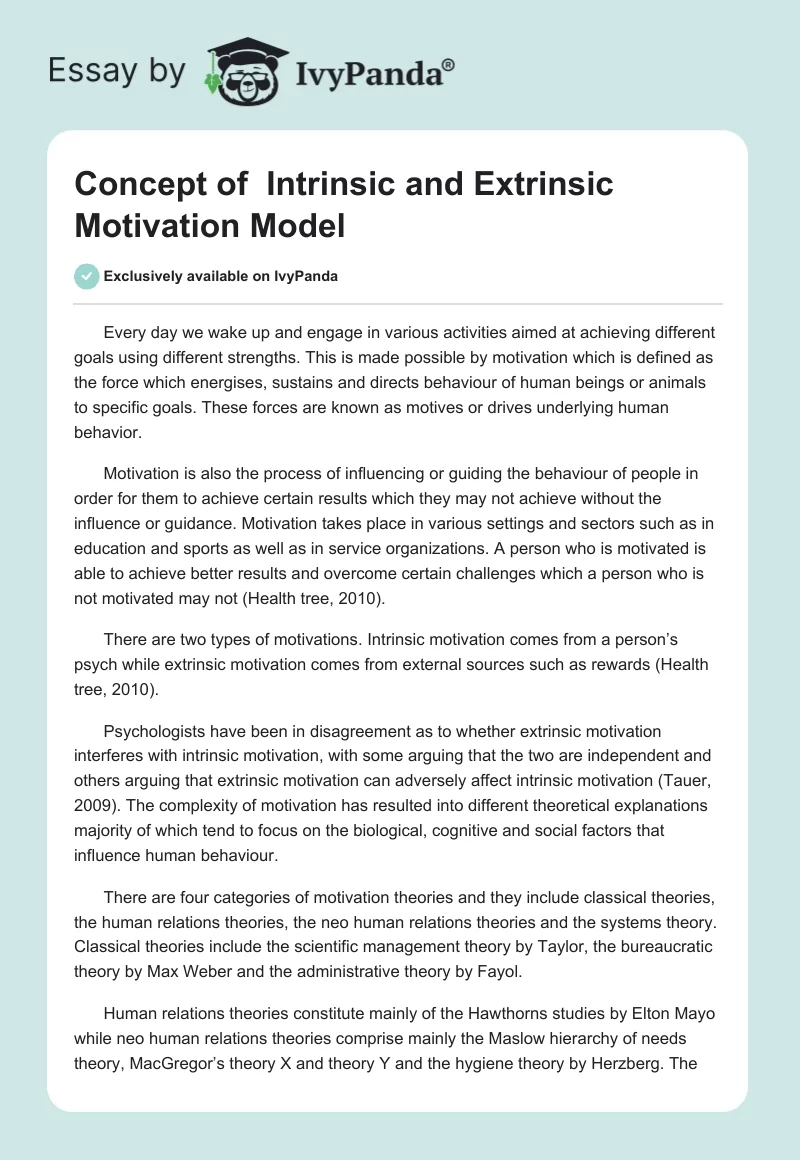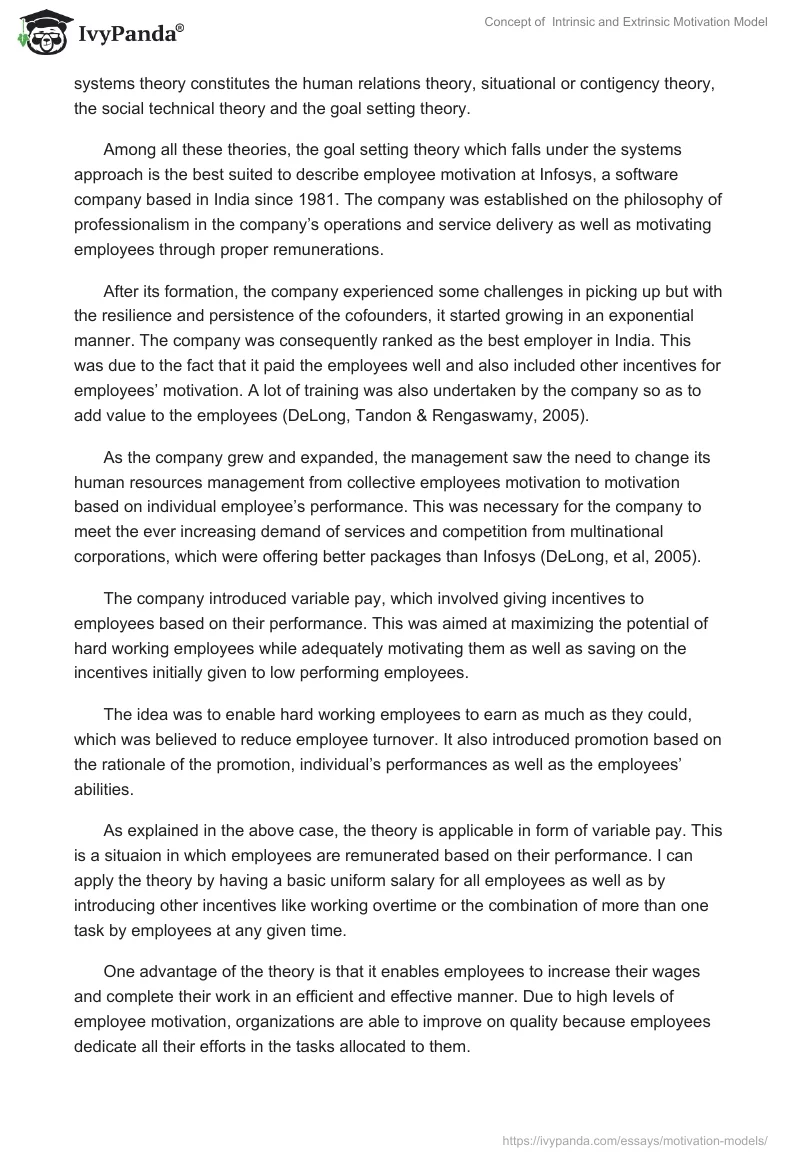Every day we wake up and engage in various activities aimed at achieving different goals using different strengths. This is made possible by motivation which is defined as the force which energises, sustains and directs behaviour of human beings or animals to specific goals. These forces are known as motives or drives underlying human behavior.
Motivation is also the process of influencing or guiding the behaviour of people in order for them to achieve certain results which they may not achieve without the influence or guidance. Motivation takes place in various settings and sectors such as in education and sports as well as in service organizations. A person who is motivated is able to achieve better results and overcome certain challenges which a person who is not motivated may not (Health tree, 2010).
There are two types of motivations. Intrinsic motivation comes from a person’s psych while extrinsic motivation comes from external sources such as rewards (Health tree, 2010).
Psychologists have been in disagreement as to whether extrinsic motivation interferes with intrinsic motivation, with some arguing that the two are independent and others arguing that extrinsic motivation can adversely affect intrinsic motivation (Tauer, 2009). The complexity of motivation has resulted into different theoretical explanations majority of which tend to focus on the biological, cognitive and social factors that influence human behaviour.
There are four categories of motivation theories and they include classical theories, the human relations theories, the neo human relations theories and the systems theory. Classical theories include the scientific management theory by Taylor, the bureaucratic theory by Max Weber and the administrative theory by Fayol.
Human relations theories constitute mainly of the Hawthorns studies by Elton Mayo while neo human relations theories comprise mainly the Maslow hierarchy of needs theory, MacGregor’s theory X and theory Y and the hygiene theory by Herzberg. The systems theory constitutes the human relations theory, situational or contigency theory, the social technical theory and the goal setting theory.
Among all these theories, the goal setting theory which falls under the systems approach is the best suited to describe employee motivation at Infosys, a software company based in India since 1981. The company was established on the philosophy of professionalism in the company’s operations and service delivery as well as motivating employees through proper remunerations.
After its formation, the company experienced some challenges in picking up but with the resilience and persistence of the cofounders, it started growing in an exponential manner. The company was consequently ranked as the best employer in India. This was due to the fact that it paid the employees well and also included other incentives for employees’ motivation. A lot of training was also undertaken by the company so as to add value to the employees (DeLong, Tandon & Rengaswamy, 2005).
As the company grew and expanded, the management saw the need to change its human resources management from collective employees motivation to motivation based on individual employee’s performance. This was necessary for the company to meet the ever increasing demand of services and competition from multinational corporations, which were offering better packages than Infosys (DeLong, et al, 2005).
The company introduced variable pay, which involved giving incentives to employees based on their performance. This was aimed at maximizing the potential of hard working employees while adequately motivating them as well as saving on the incentives initially given to low performing employees.
The idea was to enable hard working employees to earn as much as they could, which was believed to reduce employee turnover. It also introduced promotion based on the rationale of the promotion, individual’s performances as well as the employees’ abilities.
As explained in the above case, the theory is applicable in form of variable pay. This is a situaion in which employees are remunerated based on their performance. I can apply the theory by having a basic uniform salary for all employees as well as by introducing other incentives like working overtime or the combination of more than one task by employees at any given time.
One advantage of the theory is that it enables employees to increase their wages and complete their work in an efficient and effective manner. Due to high levels of employee motivation, organizations are able to improve on quality because employees dedicate all their efforts in the tasks allocated to them.
One disadvantage of the theory is that it may lead to conflict between the management and the employees especially when employees’ goals and those of management are not compatible. Employees may lack specific skills and competencies to perform some complex tasks. In such situations, the employees may engage in risky or unethical behaviours in an attempt to achieve those goals.
This may in turn compromise the quality of services offered by an organization. Lastly, there is no research which has proved that goal setting increases job satisfaction, meaning that the employees do not get the intrinsic value of work.
One of the motivational perspectives reflected in the London based BSG Electrical Ltd is teamwork. The management gives the employees the leeway to divide their work into small achievable tasks which are undertaken by a group of employees.
The idea is to replace the person’s culture (characterized by a feeling of superiority among the employees who think that they are very valuable to the organization) with task culture (characterized by the formation of groups of people with some expertise or knowledge to perform some specific tasks) (Lundy & Cowling, 1996).
The other motivational perspective used by BSG Ltd is encouraging employees to work responsibly without any supervision. It also welcomes and encourages employee flexibility, creativity and innovations as they discharge their duties. The organization abolished all rules and regulations which emphasized more on procedures and regulations and replaced them with rules which emphasized more on the end product of work irrespective of the means and procedures used to arrive at a particular result.
BSG Ltd also revised the remunerations of the employees upwards so as to increase their motivation. This reduced employee turnover which was very costly especially in terms of recruitment. High employee turnover meant that the organization was losing resources used in training and coaching the employees who ended up leaving the organization with the knowledge and training (Shim, 2010).
BSG Ltd also focuses on the work environment by ensuring that it is more conducive and attractive to the employees. The organization has in place some social benefits schemes like payment of various forms of insurance like medical cover, provision of a loaning system for advancement of employees’ education, career and training as well as other benefits like provision of leave allowances or taking the employees for paid holidays. These increases the employees’ loyalty and commitment to the organization and consequently reduces the turnover rates (Furnham & Gunter, 1993).
The use of corporate incentives has the implication of increasing the levels of motivation among employees. This happens as a result of increased wages which employees get through various incentive plans within organizations. Through the use of corporate incentives, organizations are abe to increase productivity among the employees which helps them to attain their goals in an efficient and effective manner.
References
DeLong, T.J., Tandon,J & Rengaswamy, G. (2005). Infosys (A): Strategic Human Resource Management. Harvard Business School. Web.
Furnham, A., & Gunter, B. (1993). Corporate culture: definition, diagnosis and change. In Cooper, C.L., Robertson, I.T. (Eds), International Review of Organizational Psychology,John Wiley, Chichester, 8, pp. 233-234.
Health tree. (2010). Science of Motivation. Web.
Lundy, O., & Cowling, A. (1996). Strategic human resource management. London,UK: Routledge.
Shim, M. (2010). Factors influencing child welfare employee‟s turnover: focusing onorganisational culture and climate. Children and Youth Services Review,32, pp.847-849.
Tauer, J. (2009). When Can Rewards Backfire? Web.


